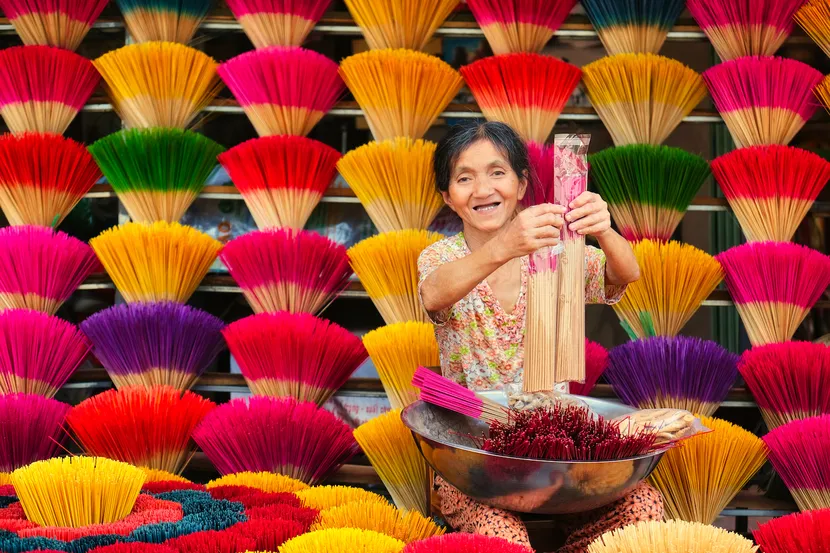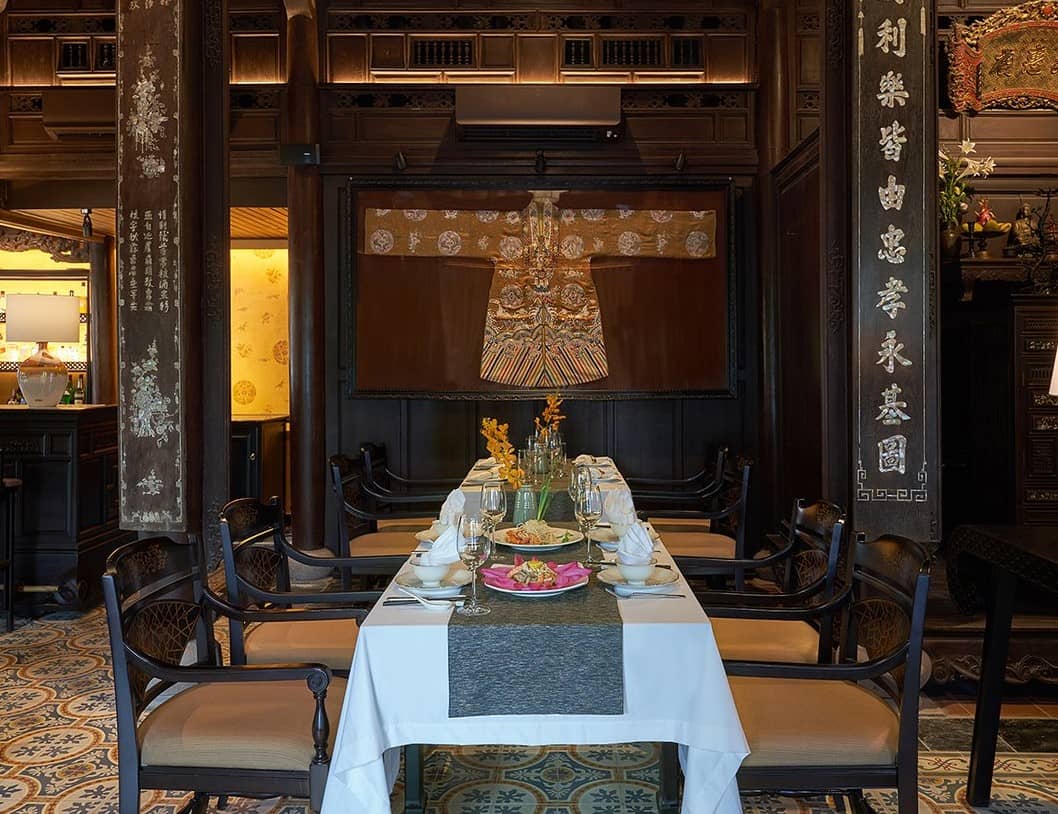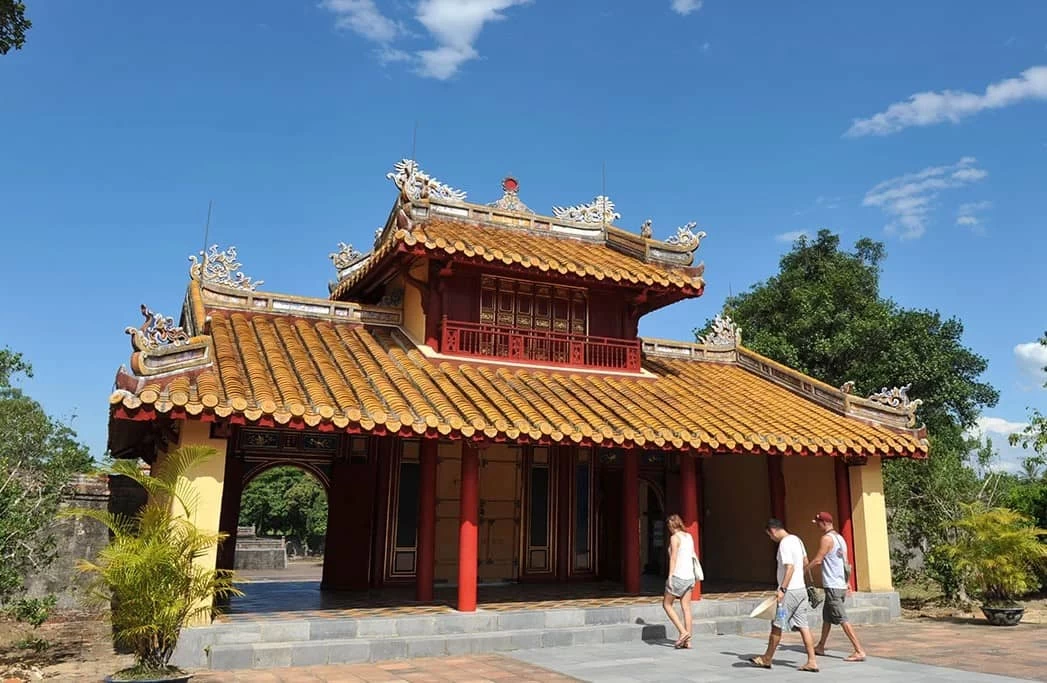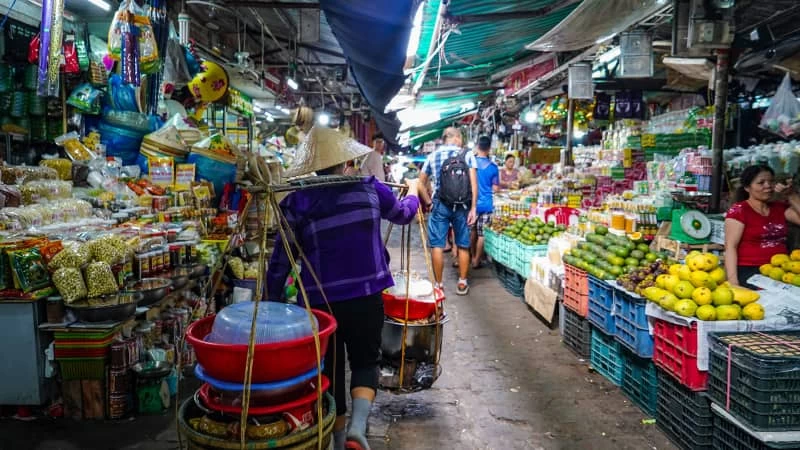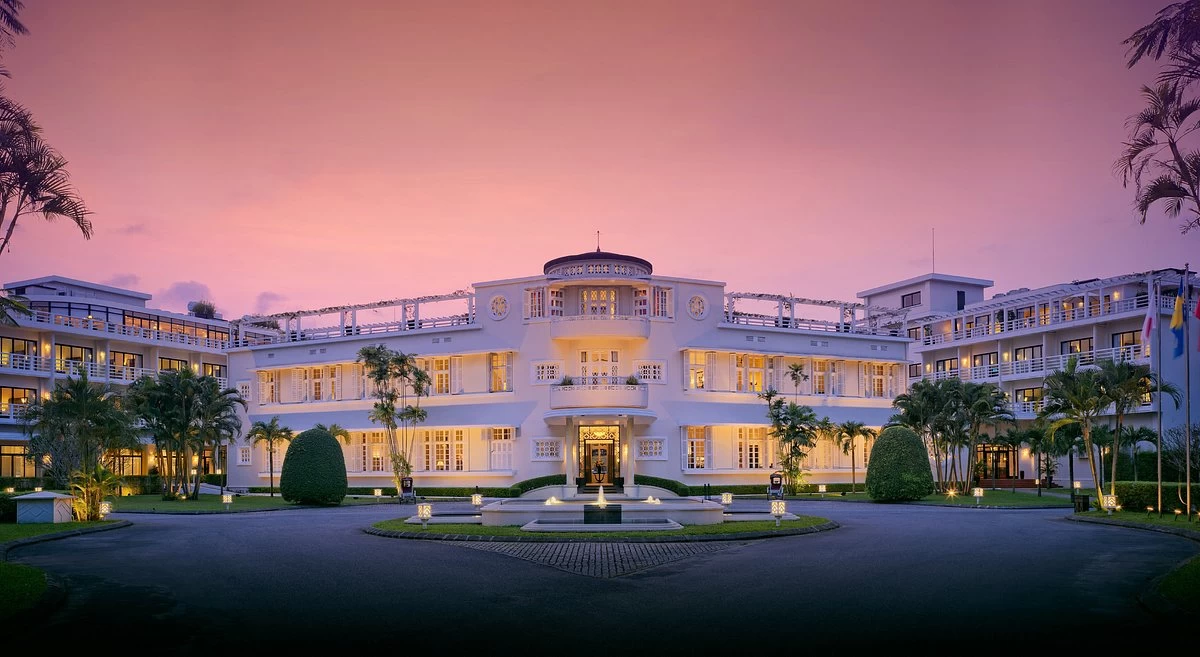Minh Mang Tomb in Hue leaves a strong impression on international tourists who visit, with its architecture deeply imbued with ancient traditional features and the spirit of Confucianism. When visitors set foot here, they have the opportunity to admire the unique artistic beauty and learn about various historical periods of Vietnam during the Nguyen Dynasty.
1. Where is Minh Mang Tomb Located?
Minh Mang Tomb, also known as Hieu Lang, is situated atop Cam Ke Mountain in Huong Tho Commune, Huong Tra Town, Thua Thien Hue Province. This location is only about 12km from the city center of Hue and near the Bang Lang intersection. The tomb complex comprises about 40 different structures.
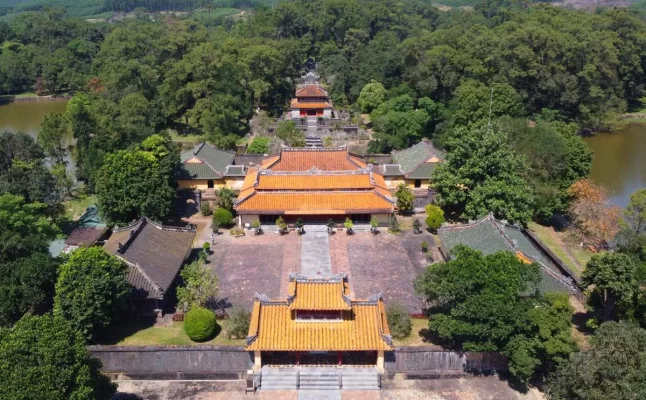
Minh Mang Tomb possesses a prime location with majestic mountain views.
According to Vietnamese historians, Minh Mang Tomb holds a strategic position, boasting picturesque landscapes of mountains and lakes. The architecture of this tomb complex vividly reflects the solemnity of the Nguyen Dynasty era. Moreover, it is a renowned tourist destination, attracting many domestic and international visitors who come to explore or learn about the history of Vietnam.
2. History of the Construction and Unique Architecture of Minh Mang Tomb
For every historical site nestled in the beautiful land of Hue, there are unique stories of its formation and distinctive architectural styles.
2.1. Formation history of Minh Mang Tomb
King Minh Mang, who succeeded King Gia Long in 1820, made significant contributions to the country’s development through various important projects. During his reign, he decided to construct a tomb, also known as Son Lang. This place was built as a resting and relaxing spot for the King after busy days of governance and ultimately served as his final resting place after his passing.
Finding the ideal location for this tomb took 14 years. The courtiers and the King finally decided on the “Cam Khe” mountain, which provided a perfect blend of natural elements such as water, mountains, and vegetation. Once the site was chosen, King Minh Mang renamed the mountain to Hieu Son and subsequently named his tomb complex “Hieu Lang.”
After thorough consideration and approval of design plans, the construction of Hieu Lang officially commenced in April 1840. However, King Minh Mang passed away during the construction phase. King Thieu Tri, upon ascending to the throne, continued the construction, and it was officially completed in 1843.
2.2. Architecture of Minh Mang Tomb
Minh Mang Tomb covers approximately 18 hectares, comprising 40 different structures arranged symmetrically. These structures are distributed along three main parallel axes, with the Than Dao Road serving as the central axis.
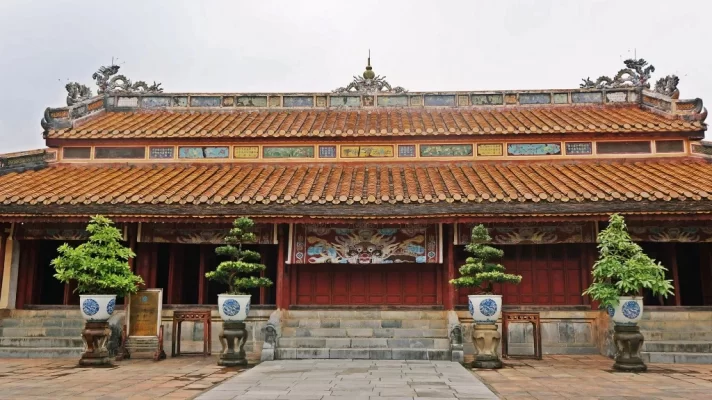
Unique architecture of Minh Mang Tomb
Minh Mang Tomb resembles a reclining figure, with its head resting against Kim Phung Mountain and its feet stretching towards the confluence of rivers. The two Trung Minh lakes on either side of the tomb are likened to two arms hanging down, creating a serene and tranquil space for the King’s ultimate comfort and relaxation.
Minh Mang Tomb is situated amidst lush greenery, with serene river views and sturdy mountains nearby. The tranquility of the tomb area is further enhanced by a lotus pond nestled within the grounds, exuding a gentle fragrance.
3. Key Attractions When Visiting the Minh Mang Tomb
Minh Mang Tomb complex was built on a large scale and comprises 40 internal structures, offering visitors numerous noteworthy points of interest. Here are 7 compelling tourist spots you shouldn’t miss when exploring this historical site:
3.1 Dai Hong Mon
Dai Hong Mon is known as the main gate leading into the Minh Mang Tomb. Constructed from lime and bricks, this structure features three pathways and 24 pitched roofs, boasting impressive architecture and unique decorative motifs of carp turning into dragons and dragon-shaped clouds.
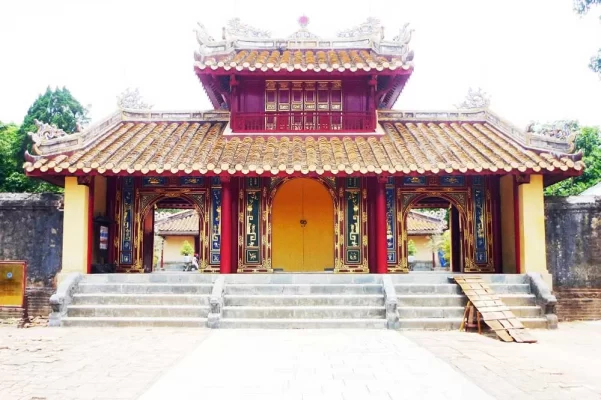
Main door of Dai Hong Mon
According to historical records, Dai Hong Mon was only opened once for the purpose of transporting the remains of King Minh Mang into the tomb, after which the gate was permanently closed. Visitors wishing to enter the tomb must pass through two auxiliary gates, namely Ta Hong Mon and Huu Hong Mon.
3.2 Bai Dinh
Right after the Dai Hong Mon structure is a vast space paved with Bat Trang bricks, known as Bai Dinh. On both sides of the courtyard are rows of sculptures depicting civil and military officials, along with stone elephants and horses standing in attendance to the King.
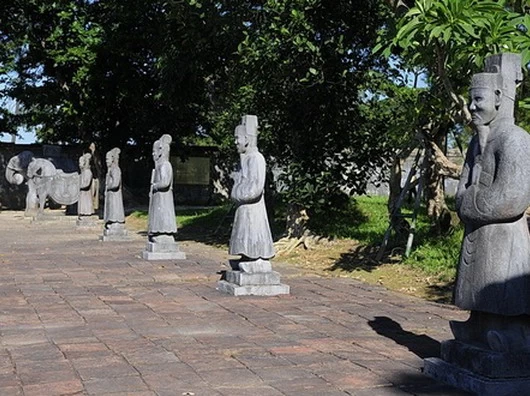
Bai Dinh area with statues of military mandarins
The highlight of this space is the stone stele “Thanh Đuc Than Cong” (Divine Virtue Deity), written by King Thieu Tri to commemorate the life and merits of his father.
3.3 Minh Lau
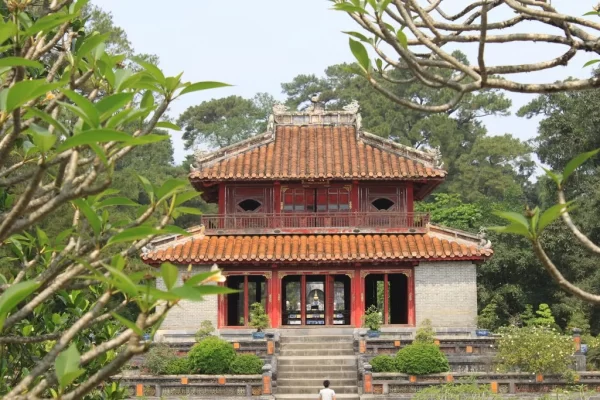
Minh Lau carries the deep meaning of Human philosophy
Next up is the image of Minh Lau, meaning ‘Bright Pavilion’, where the king would spend time relaxing on cool moonlit nights. This structure is square-shaped, with two floors and a total of eight roofs, situated atop the “Tam Dai Son” hill, with a garden in the back adorned with longevity symbols. Minh Lau is intricately designed, reflecting deeply the Confucian spirit and philosophical principles of human life.
3.4 Audience Hall
The Audience Hall consists of Filial Piety Gate and Sung An Palace, where worship is conducted for the King and the Queen Mother. Upon entering the audience hall, visitors will experience a profoundly reverent worship space.
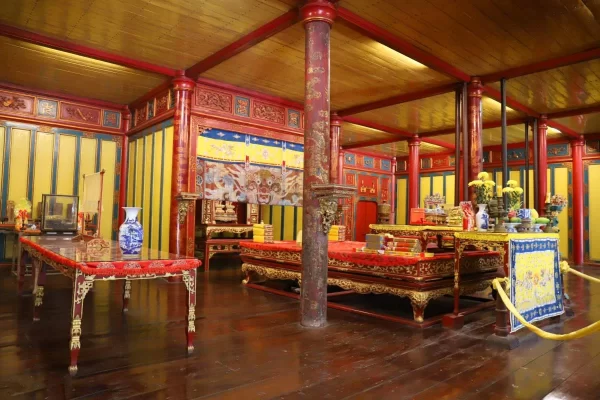
Audience Hall
This structure comprises 17 different stone terraces, leading visitors to Hoang Trach Gate. Here, you can admire the cool blue sky, the shadows of trees, the gentle fragrance of wildflowers, and the vast, serene beauty of the lake, interspersed with small lotus ponds.
3.5 Tan Nguyet Lake
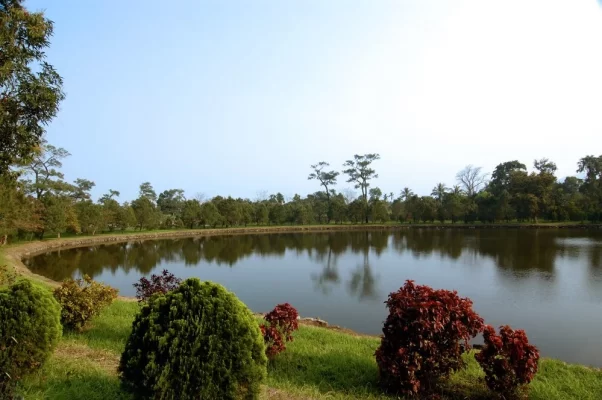
Tan Nguyet Lake
Tan Nguyet Lake is the next destination on the Minh Mang Tomb Complex tour. This lake is in the shape of a crescent moon, embracing the sun symbol of Binh Thanh. This architecture clearly reflects the ancient belief in the transformation of all things, an essential factor in creating the universe.
3.6 Straight and Honest Intelligent Bridge
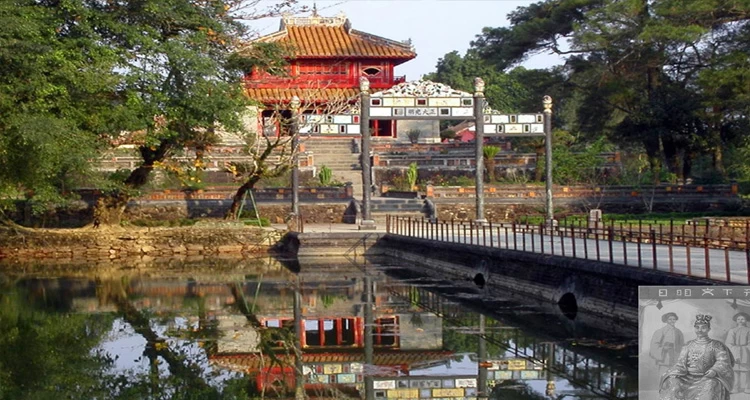
The Straight and Honest Intelligent Bridge exudes a distinct aura of antiquity
Crossing Tan Nguyet Lake, visitors will reach the Straight and Honest Intelligent Bridge, the path leading to Minh Lau Pavilion. This bridge features ancient architecture with 33 steps, bringing forth a gentle and harmonious beauty, blending with nature.
3.7 Hien Duc Gate
Hien Duc Gate is a structure within the Audience Hall area of the Minh Mang Tomb Complex, built on a square plot of land, symbolizing the Earth Deity. This place exudes a sense of solemnity, reverence, and sacredness.
Do not miss: Best things to do in Hue
4. Travel Tips for Visitors
To help facilitate travelers’ exploration of this tomb complex, here are some helpful travel tips.
4.1. Best time to visit the Minh Mang Tomb?
Early spring, from January to February, is the ideal time for visitors to explore Hue. The climate during this time is cool, less sunny, and without rain, making it conducive to travel and exploration. Famous tourist spots like the Minh Mang Tomb and other relics of the ancient capital will offer memorable and fascinating experiences to visitors.
4.2. How far is Minh Mang Tomb from the city center?
To reach the Minh Mang Tomb in Hue, you can choose one of the following transportation methods:
Option 1: Starting from the city center of Hue, you can use a taxi or rent a motorbike to travel to the tomb. Follow the QL49 route along the Perfume River to Cau Tuan. Continue straight for a while, and you will reach the tomb of King Minh Mang.
Option 2: Another interesting way to travel is by dragon boat upstream along the Perfume River. When the Tả Trạch and Hữu Trạch streams converge, visitors will arrive at the Minh Mang Tomb.
In summary, the Minh Mang Tomb, with its significant historical value, is an impressive destination that visitors should not miss when visiting the beautiful city of Hue! Since this historical site is not too far away, after exploring it, you can choose to visit Vong Canh Hill to immerse yourself in the romantic natural scenery.
See more: Hue travel tips




